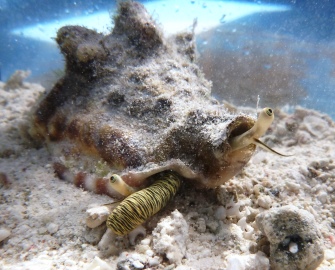Summary
Physical Description
Ecology
Feeding
Life History & Behaviour
Reproduction and Development
Locomotion
Shell Righting
Escape Response
Substrate Experiment
Anatomy & Physiology
Evolution & Systematics
Biogeographic Distribution
Human Use
References & Links | Feeding Ecology

Image of extended proboscis of Lentigo lentiginosus sweeping the substrate to pick up algae or detritus (Photographer: Asia Armstrong).
In general, Strombids feed on fine macroscopic algae and on the algae and detritus on sand grains. During feeding, sand can be picked up in the proboscis and swallowed, or macroscopic algae may be nibbled off the substrate. The presence of the crystalline style signifies a herbivorous or detrital diet for all of the strombids (Berg 1974). All of these snails graze on macroalgae and epiphytes using their extensible proboscis and radula. The proboscis is usually kept under the protective cover of the shell and the foot may be held suspended above the substratum while the animal grazes beneath it. Animals of all species observed feed during both the day and night (Berg 1975).
The recent Strombidae are exclusively herbivorous or detritivorous. In the early literature, there were anecdotal reports of Strombidae hunting other invertebrates, however recent observations have failed to confirm this behaviour (Berg 1975). Further, carrion-feeding also appears unlikely. It is possible that strombids observed engaged in this activity could have been grazing on algal or bacterial mats growing on decaying organisms (Savazzi 1991). The radula of strombids is a highly developed feeding organ that acts as a grater, rasp, brushcutter, grasper, harpoon or conveyor. The conch Strombus have a large mobile siphon adapted to sweep across the bottom like a vacuum cleaner and are deposit feeders or grazers of detritus and fine algae (Ruppert et al. 2004).
Neither strombids or xenophorids are sedentary animals, instead they are continually moving and grazing on benthic algae. The flaring lip of the strombid gives greater stability to the animals so that they do not turn themselves over when "leaping" on uneven terrain. But importantly for their feeding ecology, these extensions to the shell also act like stilts, which lift the shell up off the substrate and provide a canopy under which the animals can graze in safety (Berg 1975).
|
|